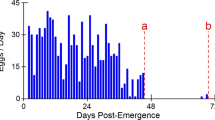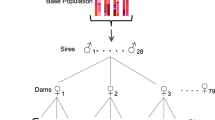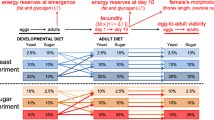Abstract
Artificial selection for increased life span in experimental populations of Drosophila melanogaster sometimes produces long-lived populations that exhibit greater fecundity than unselected controls. The absence of a trade-off between survival and reproduction in these cases might be an artefact of the rich diet of typical lab culture; if nutritional resources are not limiting then there may be no need to trade off. Here I test the rich diet hypothesis by estimating genetic correlations between survival and age-specific fecundity in three nutritional environments. Experimental material consists of 58 recombinant inbred lines derived from an artificial selection experiment. Reducing the yeast content of medium causes substantial reductions in fecundity but does not alter patterns of genetic correlation. The correlation between life span and early fecundity is non-significant in all environments, while the life span correlations with mid-life fecundity are positive and statistically significant in all environments. The rich diet hypothesis is rejected. Qualitative features of fecundity trajectories are conserved across environments, with long-lived lines exhibiting a secondary peak of oviposition in mid-life. The micro-evolution of extended life span is not a monolithic process and does not necessarily involve direct trade-offs between survival and reproduction.




Similar content being viewed by others
References
Arking R (2003) Aging: a biological perspective: a variety of techniques extend the lives of model organisms, and similar approaches might help human beings stay healthy longer. Am Sci 91:508–515
Arking R, Buck S, Novoseltsev VN, Hwangbo D-S, Lane M (2002) Genomic plasticity, energy allocations, and the extended longevity phenotypes of Drosophila. Ageing Res. Rev 1:209–228
Bubliy OA, Loeschcke V (2005) Correlated responses to selection for stress resistance and longevity in a laboratory population of Drosophila melanogaster. J Evol Biol 18:789–803
Curtsinger JW, Khazaeli AA (2002) Life span, QTLs, age-specificity, and pleiotropy in Drosophila. Mech Ageing Dev 123:81–93
Curtsinger AA, Khazaeli JW (2010) Life history variation in an artificially selected population of Drosophila melanogaster: pleiotropy, superflies, and age-specific adaptation. Evolution 64:3409–3416
Curtsinger JW, Fukui HH, Khazaeli AA, Kirscher A, Pletcher SD, Promislow DEL, Tatar M (1995) Genetic variation and aging. Annu Rev Genet 29:553–575
Drummond-Barbosa D, Spradling AC (2001) Stem cell and their progeny respond to nutritional changes during Drosophila oogenesis. Dev Biol 231:265–278
Falconer DS, Mackay TFC (1996) Introduction to quantitative genetics, 4th edn. Longman, New York
Gasser M, Kaiser M, Berrigan D, Stearns SC (2000) Life-history correlates of evolution under high and low adult mortality. Evolution 54:1260–1272
Helle S (2018) Search for a resource-based trade-off between lifetime reproductive effort and women’s postreproductive survival in preindustrial Sweden. J Gerontol Biol Sci. https://doi.org/10.1093/gerona/gly203
Khazaeli AA, Curtsinger JW (2013) Pleiotropy and life history evolution in Drosophila melanogaster: uncoupling life span and early fecundity. J Gerontol Biol Sci 68:546–553
Leroi AM, Chippindale AK, Rose MR (1994a) Long-term laboratory evolution of a genetic life-history trade-off in Drosophila melanogaster. 1. The role of genotype-by- environment interaction. Evolution 48:1244–1257
Leroi AM, Chen WR, Rose MR (1994b) Long-term laboratory evolution of a genetic life-history trade-off in Drosophila melanogaster. 2. Stability of genetic correlations. Evolution 48:1258–1268
Luckinbill LS, Clare MJ (1985) Selection for life span in Drosophila melanogaster. Heredity 55:9–18
Luckinbill LS, Clare MJ (1987) Successful selection for increased longevity in Drosophila: analysis of the survival data and presentation of a hypothesis on the genetic regulation of longevity. Exp Gerontol 22:221–226
Luckinbill LS, Arking R, Clare MJ, Cirocco WC, Buck SA (1984) Selection for delayed senescence in Drosophila melanogaster. Evolution 38:996–1003
Moghadam NN, Holmstrup M, Manenti T, Mouridsen MB, Pertoldi C, Loeschcke V (2015) The role of storage lipids in the relation between fecundity, locomotor activity, and life span of Drosophila melanogaster longevity-selected and control lines. PLoS ONE 10:e0130334
Partridge L, Fowler K (1992) Direct and correlated responses to selection on age at reproduction in Drosophila melanogaster. Evolution 46:76–91
Partridge L, Prowse N, Pignatelli P (1999) Another set of responses and correlated responses to selection on age at reproduction in Drosophila melanogaster. Proc R Soc Lond B Biol Sci 266:255–261
Promislow DEL, Tatar M, Khazaeli AA, Curtsinger JW (1996) Age-specific patterns of genetic variation in Drosophila melanogaster I. Mortality. Genetics 143:839–848
Rose MR (1984) Laboratory evolution of postponed senescence in Drosophila melanogaster. Evolution 38:1004–1010
Schwartz MB, Kelly TJ, Imberski RB, Rubenstein EC (1985) The effects of nutrition and methoprene treatment on ovarian ecdysteriod synthesis in Drosophila melanogaster. J Insect Physiol 31:947–957
Stearns SC, Ackermann M, Doebeli M, Kaiser M (2000) Experimental evolution of aging, growth, and reproduction in fruitflies. Proc Natl Acad Sci USA 97:3309–3313
Vermeulen CJ, Bijlsma R (2006) Changes in genetic architecture during relaxation in Drosophila melanogaster selected on divergent virgin life span. J Evol Biol 19:216–227
Wit J, Sarup P, Lupsa N, Malte H, Frydenberg J, Loeschcke V (2013) Longevity for free? Increased reproduction with limited trade-offs in Drosophila melanogaster selected for increased life span. Exp Gerontol 48:349–357
Zwaan BJ, Bijlsma R, Hoekstra RE (1995) Direct selection on life span in Drosophila melanogaster. Evolution 49:649–659
Acknowledgements
I thank A. Khazaeli (University of Minnesota) for technical assistance and for comments on an early draft of this manuscript.
Author information
Authors and Affiliations
Corresponding author
Ethics declarations
Conflict of interest
The author claims no conflict of interest.
Additional information
Publisher's Note
Springer Nature remains neutral with regard to jurisdictional claims in published maps and institutional affiliations.
Electronic supplementary material
Below is the link to the electronic supplementary material.
Rights and permissions
About this article
Cite this article
Curtsinger, J.W. Fecundity for free? Enhanced oviposition in longevous populations of Drosophila melanogaster. Biogerontology 20, 397–404 (2019). https://doi.org/10.1007/s10522-018-09791-1
Received:
Accepted:
Published:
Issue Date:
DOI: https://doi.org/10.1007/s10522-018-09791-1




